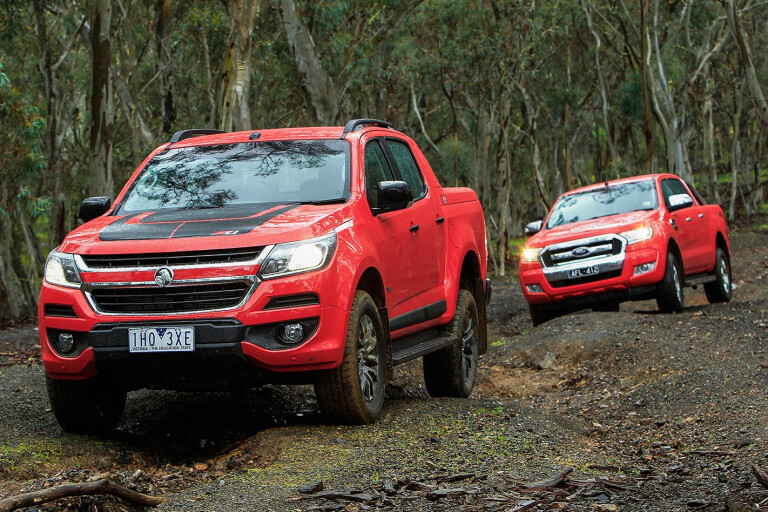
HOLDEN verses Ford. It’s the classic Australian stoush played out most dramatically at Mount Panorama each October, but more crucially in car showrooms every day. The specific combatants have traditionally been the Commodore and the Falcon, but now that’s changed.
For Ford the Ranger is its best seller, even before Falcon production stopped, while over at Holden the Colorado is second only to the Commodore in sales and looks set to move into the number one spot once Holden closes down local production next year – including that of its Commodore-based 4x2 ute, which will no doubt boost Colorado 4x2 sales.
That’s in the future. What we have right now is Holden’s revised-from-the-ground-up Colorado taking on Ford’s Ranger for the next instalment of ‘King of the (Dirt) Mountain’.
FORD RANGER XLT: TRUE BLUE
 Last year’s mid-generation changes have refined and polished the big, tough and blokey Ford Ranger.
Last year’s mid-generation changes have refined and polished the big, tough and blokey Ford Ranger.
THIS is the ute Ford Australia designed and developed for the world. Well, most of the world anyway. The Ranger isn’t quite sold everywhere, most notably in the USA and Canada, although this is set to change when Ranger production starts up in Michigan, USA, in 2018.
Meanwhile, our Ranger, like all of the popular utes (bar the VW Amarok) sold here, is built in Thailand. From its introduction late in 2011 the PX Ranger was a winner, both in what it did and how it sold.
Following its 2015 refresh the Ranger drives and performs ever better and is selling more strongly. Year-to-date (September ’16) Ranger 4x4 sales are less than 100 units (22,438 versus 22,524) behind the once completely dominant Toyota Hilux.
 The mid-generational changes brought new front-end styling and a fresh dashboard, but hidden under the bonnet was a smaller, more efficient turbo, new fuel injectors, cylinder head changes and various measures to improve engine NVH. The Ranger also gained electric power steering and enhanced electronic control of the 4x4 system.
The mid-generational changes brought new front-end styling and a fresh dashboard, but hidden under the bonnet was a smaller, more efficient turbo, new fuel injectors, cylinder head changes and various measures to improve engine NVH. The Ranger also gained electric power steering and enhanced electronic control of the 4x4 system.
POWERTRAIN AND PERFORMANCE
WHAT hasn’t changed are the engine basics. Aside from the mechanically similar Mazda BT-50, the relatively big 3.2-litre five-cylinder engine is unique in this class. A little lumpy at idle, but smoothing out nicely with a few revs on board, the ‘big-five’ is lazy and relaxed compared to the four-cylinder engines in competitor utes. It also uses less revs and generally taller gears to go about its business.
Strange as it may sound, an inline-five offers better dynamic balance than an inline-four due to the inline-four’s inherent vibration, which occurs at twice crankshaft speed and is the source of a four’s often ‘buzzy’ feel. This problem is usually addressed through the use of crankshaft-driven (and power-robbing) rotating balance shafts.
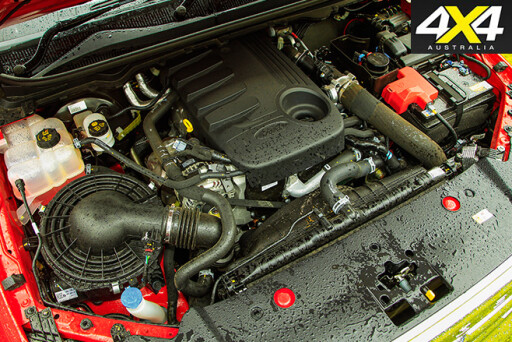 Pedal to the metal, the Ranger is an effective match for the Colorado, despite the Colorado’s higher peak torque (500Nm) and slightly trimmer weight.
Pedal to the metal, the Ranger is an effective match for the Colorado, despite the Colorado’s higher peak torque (500Nm) and slightly trimmer weight.
The 2015 changes have made Ford’s 3.2 more responsive at low revs and generally much quieter overall, although there’s still some gruffness about this engine. It is, after all, a commercial-vehicle-derived diesel engine rather than a passenger car diesel, coming as it did from the European Transit van. Still, in terms of refinement, it’s up there with the vastly improved Colorado.
As ever the Ford six-speed ZF auto is agreeable and works nicely with the grunty engine; although, on throttle-off descents it isn’t as proactive in backshifting as the Colorado’s generally more sportily-tuned GM six-speeder.
ON-ROAD RIDE AND HANDLING
FORD hit the on-road ride, handing and steering sweet spot right from the Ranger’s debut in 2011. The mechanically near-identical Mazda BT-50, released weeks later, had a slightly sharper suspension and steering tune than the Ranger, but it wasn’t as nice.
 Fast forward to today and the Ranger is still towards the head of the ride-and-handling pack, but now has the benefit of much-reduced steering effort at low speeds thanks to its electric power steering. This is more than welcome given the Ranger, along with the BT-50, is the biggest and heaviest vehicle in its class and has the longest wheelbase.
Fast forward to today and the Ranger is still towards the head of the ride-and-handling pack, but now has the benefit of much-reduced steering effort at low speeds thanks to its electric power steering. This is more than welcome given the Ranger, along with the BT-50, is the biggest and heaviest vehicle in its class and has the longest wheelbase.
At speed the Ranger’s electric steering weighs up nicely and, as ever, ride and handling balance remains hard to criticise. Sure, unladen there’s firmness at the rear, but overall it’s composed, stable and surprisingly compliant. Where it shines against the Colorado is not on good roads, but on bad roads.
OFF-ROAD
THE Ranger’s size can work against it off-road, but that’s about the only entry in the negative column. Most importantly the Ranger’s chassis provides generous suspension travel by ute standards – certainly more than the Colorado, which is critical in this contest.
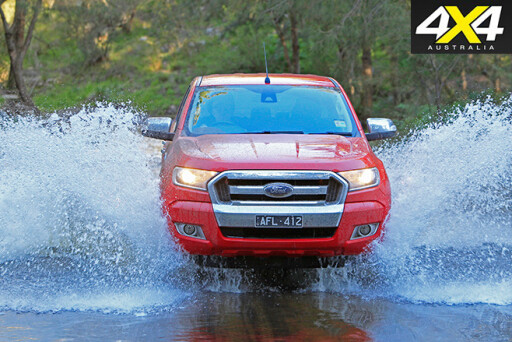 If extra wheel travel isn’t enough, the Ranger also comes standard with a driver-switched rear diff lock, which is now far more effective than it was prior to the 2015 mid-generation upgrade. Previously, when the driver engaged the rear locker, it cancelled the electronic traction control across both axles.
If extra wheel travel isn’t enough, the Ranger also comes standard with a driver-switched rear diff lock, which is now far more effective than it was prior to the 2015 mid-generation upgrade. Previously, when the driver engaged the rear locker, it cancelled the electronic traction control across both axles.
Now, when the rear locker is engaged, the ETC remains active on the front axle, which makes a huge difference and helps put the Ranger with the best when it comes to off-road performance. It’s certainly a good step ahead of the Colorado.
CABIN AND ACCOMMODATION
THE Ranger’s size mightn’t help when parking or off-road, but the upside is a class-leader when it comes to cabin space. Along with the BT-50, the Ranger has the longest cabin among the popular utes and is only bettered in width by the Amarok. On both counts it’s ahead of the Colorado, benefitting rear-seat passengers the most.
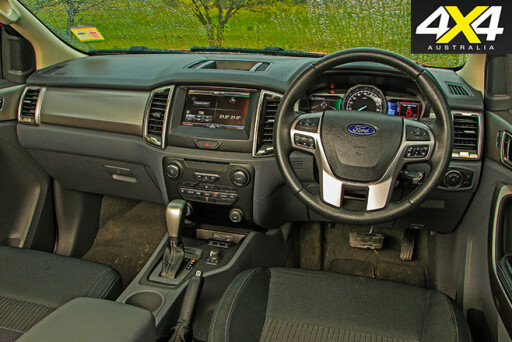 Up front the Ranger also feels big and spacious and, even if there’s no reach adjustment for the steering wheel, it’s a comfortable place to be. Nicer front seats than the Colorado, too.
Up front the Ranger also feels big and spacious and, even if there’s no reach adjustment for the steering wheel, it’s a comfortable place to be. Nicer front seats than the Colorado, too.
PRACTICALITIES
OUR recent load and tow test (November 2016) crowned the Ranger as the carrying and towing king. Having a 3500kg towbar, ugly as it is, as standard on the XLT is a bonus, as is the fact that all Ranger dual-cab pick-ups have six rather then four tie-downs in the tub. XLT and Wildtrak models also get a 12-volt outlet in the tub.
Under the gas-strutted bonnet there’s room for a small second battery, a high-mounted alternator and air intake via the inner guard. The 265/65R17 tyre and wheel spec is also as practical as it comes.
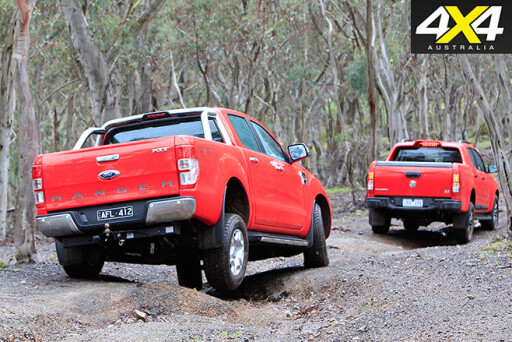 EQUIPMENT
EQUIPMENT
ALL Ranger 4x4 dual-cab pick-ups have a five-star ANCAP safety rating, six airbags, and stability and trailer-sway control. Cruise, Bluetooth, auto headlights and a rear locker are also standard. All Ranger dual-cabs bar the XL Plus also have a 230V outlet in the cabin. The XL Plus gets an aux battery and 17in steelies.
The XLS adds carpet and 17in alloys. The XLT adds sat-nav in a larger touchscreen, dual-zone climate, a centre-console cooler, rear parking sensors, auto wipers, tyre pressure sensors, 12V in the tub, a sportsbar, sidesteps and a 3500kg-rated towbar.
Wildtrak adds a reversing camera, front parking sensors, heated front seats, 18in alloys, and a lockable roller cover.
An optional Tech pack for the XLT and Wildtrak includes radar cruise control, forward-collision warning, lane-departure warning and a driver-impairment monitor.
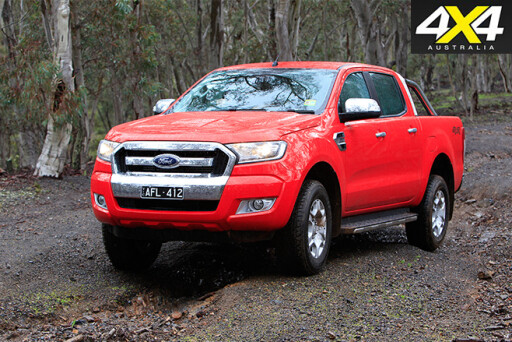 SPECS: FORD RANGER*
SPECS: FORD RANGER*
Engine: 3.2-litre 5-cyl turbo-diesel
Max power: 147kW @ 3000rpm
Max torque: 470Nm @ 1500-2750rpm
Gearbox: six-speed automatic
4x4 system: dual-range part-time
Crawl ratio: 42.3:1
Construction: separate chassis
Front suspension: independent/coil springs
Rear suspension: live axle/leaf springs
Kerb weight: 2068kg -2200kg
GVM: 3200kg
Payload: 1000kg -1132kg
Towing capacity: 3500kg
Towball download: 350kg
GCM: 6000kg
Fuel tank capacity: 80 litres
ADR fuel claim: 9.2L/100km
Test fuel use: 12.1L/100km
Touring range: 611km**
*4x4 dual-cab pick-up autos only.
FORD RANGER PRICES*
XL: $47,565
XL PLUS (auto): $53,235
XLS: $48,865
XLT: $55,425
WILDTRAK: $59,590
*3.2L 4x4 dual-cab pick-up manuals only, unless noted.
HOLDEN COLORADO Z71: FRESH START
 The Colorado may be a global GM product, but Aussie engineers have played an even greater role in this mid-generation remake.
The Colorado may be a global GM product, but Aussie engineers have played an even greater role in this mid-generation remake.
WHAT we have here is the top-spec Colorado dual-cab 4x4, the Z71. It’s not exactly the Colorado we wanted for this test, but it’s not exactly wrong either. What we asked for was a LTZ dual-cab – one spec down from the Z71 – to compare with the volume-selling Ranger XLT.
The good news is that this top-spec Colorado is actually a price match with the upper-mid spec Ranger XLT, which is always a valid starting point for a comparison test. Either way, the Z71 and the LTZ are mechanically identical; the Z71 just adds the rear body kit and leather and heated front seats, among a few details.
The Colorado arrives after a ground-up remake: it’s been pulled completely apart and put back together.
 This generation Colorado is a GM product and not a re-badged Isuzu, and it emerged in 2012 from a GM design and development program based in Brazil. A year later it was tweaked, and again in 2014, before this major overhaul for 2017.
This generation Colorado is a GM product and not a re-badged Isuzu, and it emerged in 2012 from a GM design and development program based in Brazil. A year later it was tweaked, and again in 2014, before this major overhaul for 2017.
Most of the latest changes are aimed at improving refinement, with relocated engine balance shafts, revised fuel injection, additional injector soundproofing, a new torque convertor for the auto, shorter final-drive gearing for the manual, new engine and transmission mounts, new body mounts, recalibrated suspension and electric power steering.
Also aimed at refinement are revised roof mouldings, exterior mirror mounts, door seals, sliding glass channels, B-pillar inserts, and a thicker windscreen. So there’s not much that hasn’t been worked over.
POWERTRAIN AND PERFORMANCE
THE engine remains the 2.8-litre four-cylinder from Italian diesel specialist VM Motori, part of the seemingly ever-growing Fiat empire. As before, the engine claims maximums of 147kW and 500Nm, although fuel mapping has been tweaked for better driveability.
What you notice most is how much quieter and more refined this engine is than before, which is a more than welcome change from the generally unpleasant, rough and gruff thing it was before. It’s still no Amarok in terms of noise and running refinement, but it’s now a match for the Ranger and may even be a bit quieter. Either way, it’s now a very pleasant engine – something you couldn’t say about it previously.
 There’s plenty of performance from its 2.8 litres and, pedal to the metal, the Colorado matches and can even better the bigger five-cylinder engine in the Ranger, although it does rev harder in the process. Peak power is at 3600rpm compared to the Ranger’s 3000.
There’s plenty of performance from its 2.8 litres and, pedal to the metal, the Colorado matches and can even better the bigger five-cylinder engine in the Ranger, although it does rev harder in the process. Peak power is at 3600rpm compared to the Ranger’s 3000.
The Colorado’s cause is helped by what is now a very good auto gearbox, with smoother, quicker and ‘smarter’ shifts than before thanks to the new torque converter and revised shift protocols. While no smoother than the Ranger’s six-speed, it’s a more proactive in its shifts, something you notice on demanding, hilly, winding roads.
ON-ROAD RIDE AND HANDLING
AMONG the chassis changes, the new Colorado’s electric power steering is the one you most notice. The benefit is very light steering at parking speeds, combined with more weight and feel at highway speeds.
In practice it works very nicely, and with the front suspension changes that run to softer springs, a thicker sway bar and digressive rather than linear front dampers, it provides a front end with more feel and a generally more compliant and comfortable ride than before. On the downside, the front end also seems to ‘crash’ more on the nasty washouts, potholes and bumps you might find on poorly maintained back roads, when hit at speed.
 The rear spring pack, previously only fitted to the Z71 but now common across the range, combines a much softer initial rate and a slightly firmer final rate than the default spring pack fitted to non-Z71 variants before the MY17 update. It’s surprisingly comfortable, even when unladen. As with the front, the rear now has digressive rather than linear dampers.
The rear spring pack, previously only fitted to the Z71 but now common across the range, combines a much softer initial rate and a slightly firmer final rate than the default spring pack fitted to non-Z71 variants before the MY17 update. It’s surprisingly comfortable, even when unladen. As with the front, the rear now has digressive rather than linear dampers.
Interestingly, of all the popular utes, the Colorado is the only one to run a mechanical rear limited-slip diff in addition to electronic traction control. The idea is that the limited-slipper takes care of moderate wheelspin so ETC isn’t triggered – potentially cutting engine power – when the driver is entering a moving traffic steam on a wet road and needs maximum acceleration.
OFF-ROAD
THE Colorado’s new electric power steering is a winner off-road in terms of much-reduced steering effort. The softer suspension generally works better for low-range work, while Holden has also worked on the electronic traction control to improve its off-road effectiveness.
 The end result is a better ute when the road stops and the tracks start, but the Colorado is still not a front-runner when it comes to vehicle-stopping conditions. Crucially the chassis doesn’t have as much travel as some competitors, the Ranger included. The Colorado also lacks a rear locker, and while all rear lockers fitted to current utes aren’t effective as they could be, the one on the Ranger certainly is.
The end result is a better ute when the road stops and the tracks start, but the Colorado is still not a front-runner when it comes to vehicle-stopping conditions. Crucially the chassis doesn’t have as much travel as some competitors, the Ranger included. The Colorado also lacks a rear locker, and while all rear lockers fitted to current utes aren’t effective as they could be, the one on the Ranger certainly is.
CABIN AND ACCOMMODATION
THERE’S more good news in the Colorado’s cabin, with much improved fit and finish that brings a quality feel lacking in previous Colorados. There’s more equipment, too, right across the dual-cab range.
At Z71 spec the Colorado feels quite luxurious thanks to its heated leather seats, although all Colorados lack tilt-and-reach steering wheel adjustment. That said, the driving position is comfortable and provides shorter drivers with good vision over the bonnet and to the sides.
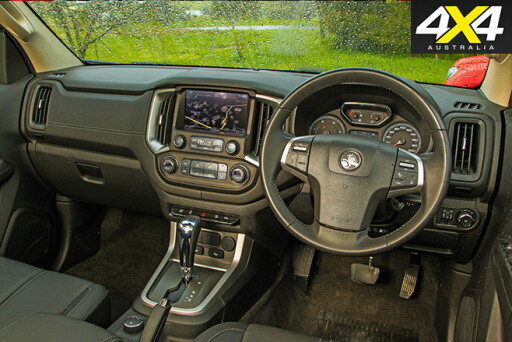 It’s got one of the bigger and better back seats, too, if you need to accommodate three adults – even if it’s not as roomy as the Ranger.
It’s got one of the bigger and better back seats, too, if you need to accommodate three adults – even if it’s not as roomy as the Ranger.
PRACTICALITIES
ALL Colorado dual-cab 4x4s are rated to carry more than a tonne (1000kg total payload) and tow 3500kg. From our recent tow test we know the Colorado does both with reasonable ease.
Off-road practicalities include two front tie down points – but none at the rear – a large air filter that draws via the inner mudguard, and a high-mounted alternator. Unfortunately there’s little room for a second battery.
The Z71 runs on 265/60R18 tyres and, if the 18-inch wheels aren’t to your liking, you can always fit the 17s from the LT, which will open up a wider choice of all-terrain rubber.
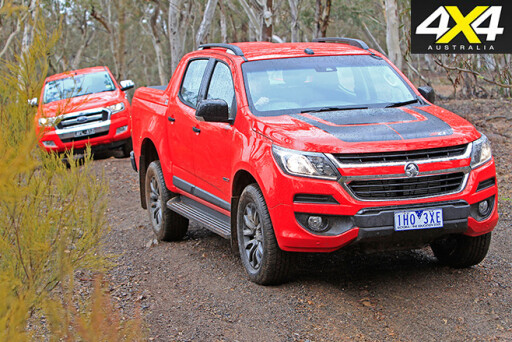 EQUIPMENT
EQUIPMENT
ALL Colorado 4x4 dual-cab pick-ups have a five-star ANCAP safety rating, seven airbags, stability and trailer-sway control, and a reversing camera. Cruise, Bluetooth, rear parking sensors, a digital radio and a touchscreen supporting Apple CarPlay and Android Auto are standard.
The LT adds 17-inch alloys, fogs and sidesteps. The LTZ then adds 18s, a bigger touchscreen with inbuilt sat-nav, auto wipers, front parking sensors, tyre-pressure sensors, electric driver’s seat adjustment, a soft tonneau, a sportsbar, lane-departure warning, and forward-collision alert.
The top-spec Z71 adds heated front leather seats, roof rails and a tub-mounted body kit. Holden also offers various accessories for the Colorado including bullbars, underbody protection and all-terrain tyres.
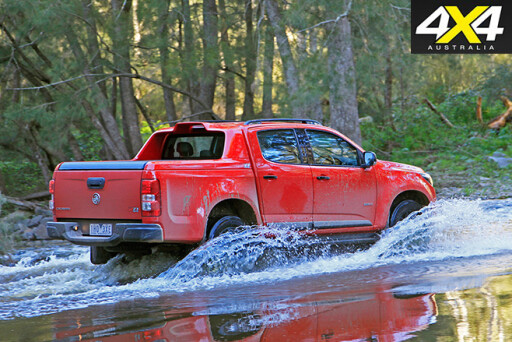 SPECS: HOLDEN COLORADO*
SPECS: HOLDEN COLORADO*
Engine: 2.8-litre 4-cyl turbo-diesel
Max Power: 147kW @ 3600rpm
Max Torque: 500Nm @ 2000rpm
Gearbox: six-speed automatic
4x4 system: dual-range part-time
Crawl ratio: 36.8:1
Construction: separate chassis
Front suspension: independent/coil springs
Rear suspension: live axle/leaf springs
Kerb weight: 2065kg to 2143kg
GVM: 3150kg
Payload: 1007kg to 1085kg
Towing capacity: 3500kg
Towball download: 350kg
GCM: 6000kg
Fuel tank capacity: 76 litres
ADR fuel claim: 8.7L/100km
Test fuel use: 12.7L/100km
Touring range: 548km**
*4x4 dual-cab pick-up auto only.
**Based on test fuel use, claimed fuel capacity and a 50km ‘safety’ margin.
HOLDEN COLORADO PRICES*
LS: $44,990
LT: $46,990
LTZ: $50,990
Z71: $54,490
*4x4 dual-cab pick-up manuals only.
THE VERDICT
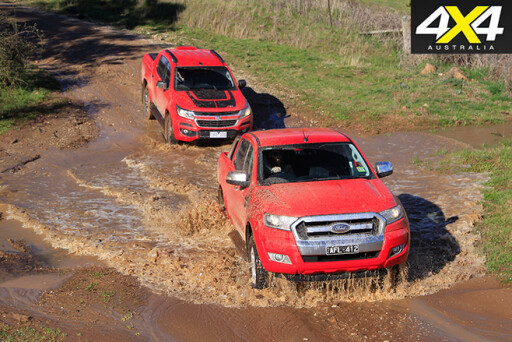 HOLDEN’S re-engineering of its Colorado for 2017 has been highly successful, propelling it from disappointing tailender to a good thing among the eight popular 4x4 dual-cabs. The Ranger, on the other hand, has always been a good thing, ever since it arrived in 2011, a year before the Colorado. It became a whole lot better thanks to a mid-generation upgrade in 2015.
HOLDEN’S re-engineering of its Colorado for 2017 has been highly successful, propelling it from disappointing tailender to a good thing among the eight popular 4x4 dual-cabs. The Ranger, on the other hand, has always been a good thing, ever since it arrived in 2011, a year before the Colorado. It became a whole lot better thanks to a mid-generation upgrade in 2015.
However, Holden has moved the Colorado on more in this upgrade than Ford did last year with its Ranger. But then again, something special had to be done, given the Colorado was previously so far towards the back of the pack.
The Colorado has improved to the point that in many ways it’s now the equal of the Ranger in what it does and doesn’t do.
On-road the two are now a close match in terms of refinement, comfort and general driveability. The Colorado’s smaller engine doesn’t give it a performance disadvantage, either. In fact, it can even feel a bit sportier than the Ranger thanks to its gearbox tune and higher peak engine torque – and being a bit lighter doesn’t hurt.
 The Colorado’s on-road dynamics, at least on better roads, also have a sporty edge to them compared to the Ranger. It feels a bit smaller and more agile than the slightly longer and bigger Ranger. There’s generally a nicer steering feel in the Colorado, too.
The Colorado’s on-road dynamics, at least on better roads, also have a sporty edge to them compared to the Ranger. It feels a bit smaller and more agile than the slightly longer and bigger Ranger. There’s generally a nicer steering feel in the Colorado, too.
But things start to go downhill for the Colorado once the roads deteriorate. It doesn’t handle the bumps as well as the more compliant and supple Ranger. Things unravel even more compared to the Ranger off-road, thanks to less suspension travel, no rear locker and less effective chassis electronics.
That said, the Colorado will still comfortably do 99 per cent of what most people will ever want to do off-road; it’s just that the Ranger, in its post-2015 iteration at least, is a stand-out performer off-road.
Throw in its extra cabin space and towing and load-carrying prowess and you can see why it justifies the extra cost.

COMMENTS